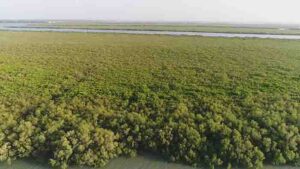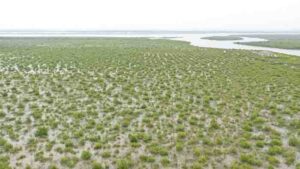NE ENVIRONMENT BUREAU
GANDHINAGAR, JULY 25

With dedicated commitment to protect and revitalize the essential coastal ecosystem, over the last thirty years, Gujarat has made remarkable strides in mangrove conservation, establishing itself as one of the front-runner states. Nationally, Gujarat stands second after West Bengal in mangrove cover, expanding its cover from 397 square kilometers in 1991 to 1,175 square kilometers by 2021.


Incidentally, Gujarat was the first state in the country to establish a separate Climate Department under the guidance of Prime Minister Narendra Modi when he was the Vibrant Gujarat CM.
- Incidentally, Gujarat was the first state in the country to establish a separate Climate Department under the guidance of Prime Minister Narendra Modi when he was the Vibrant Gujarat CM
- Kachchh district leads with 799 square kilometers of mangrove cover
- Nationally, Gujarat stands second after West Bengal in mangrove cover
- In 2023-24, Gujarat completed 6,930 hectares of new mangrove plantation, with plans to plant mangroves in an area of over 12,000 hectares in 2024-25
- Approximately 1,500 species of plants and animals, including fish and birds, rely on mangroves, utilizing the shallow waters beneath the trees as breeding grounds
Treading the path of visionary PM, and the leadership of Chief Minister Bhupendra Patel, Gujarat Government’s persistent efforts in mangrove plantation and conservation have yielded results, positioning Gujarat as a role model in mangrove conservation. The enhanced mangrove cover not only increases biodiversity but also fortifies coastal resilience against erosion and extreme weather events, ensuring a secure and sustainable future for the Gujarat’s coastal communities and ecosystems.

Discussing the expansion of mangrove cover in Gujarat, Forest and Environment Minister Mulubhai Bera stated, “The Gujarat government has made a concerted effort to increase mangrove plantations in the state, resulting in an expansion of mangrove cover to 1,175 square kilometers. Nationally, Gujarat now ranks second in terms of mangrove cover, which is a remarkable achievement. Prime Minister Narendra Modi has consistently emphasized sustainable development through environmental conservation. Under the leadership of Chief Minister Bhupendra Patel, Gujarat is committed to environmental protection, thereby realizing the vision of Viksit Gujarat to Viksit Bharat.
To further strengthen this critical ecosystem, the Gujarat government initiated an extensive mangrove plantation campaign from 2014-15 to 2022-23. Plantation efforts expanded in 2016-17, covering 9,080 hectares, with the Gulf of Kutch seeing the most significant expansion adding 4,920 hectares of new plantation. The plantations efforts continue, tailored to the unique needs of each region. In 2023-24, Gujarat completed 6,930 hectares of new mangrove plantation, with plans to plant mangroves in an area of over 12,000 hectares in 2024-25.
Mangroves: Strategic distribution across Gujarat
Gujarat’s mangrove cover is strategically distributed across four main areas of the state. The Kachchh district leads with 799 square kilometers of mangrove cover, constituting the majority of the state’s mangrove area. The Gulf of Kutch, including regions like Marine National Park and Sanctuary, Jamnagar, Rajkot (Morbi), Porbandar, and Devbhoomi Dwarka, contributes an additional 236 square kilometers of mangrove cover.
Central and Southern Gujarat, covering the Gulf of Khambhat and Dumas-Ubharat areas and districts such as Bhavnagar, Ahmedabad, Anand, Bharuch, Surat, Navsari, and Valsad, accounts for 134 square kilometers of mangrove area. The Saurashtra region, encompassing districts like Amreli, Junagadh, and Gir-Somnath, holds a modest 6 square kilometers of mangrove cover.
Importance of the mangrove ecosystem
Mangroves are coastal forests comprising of trees that thrive in saline water. They play a crucial role in enhancing water quality through nutrient and sediment filtration. These ecosystems are vital for supporting marine life, stabilizing coastal soils, preventing saline intrusion, and buffering against natural disasters like hurricanes. Approximately 1,500 species of plants and animals, including fish and birds, rely on mangroves, utilizing the shallow waters beneath the trees as breeding grounds.
Recent research indicates that mangroves are also vital for mammals such as monkeys, sloths, tigers, hyenas (Jarakh), and African wild dogs. These findings highlight the extensive ecological significance of mangroves, extending beyond their traditional role as nurseries for fish and birds.
Gujarat’s dedication to mangrove conservation serves as a model not only for India but also for other nations. With its expansive 1,650 km coastline along the Arabian Sea, accounting for over 21% of India’s total coastline, Gujarat provides an ideal habitat for diverse ecosystems, including mangroves, corals, and seagrasses like green algae. The natural richness, combined with the state’s conservation initiatives, positions Gujarat as a global leader in environmental sustainability.
Gujarat’s substantial growth in mangrove cover over the last two decades demonstrates its unwavering commitment to environmental protection. By strategically planting mangroves in key areas and receiving strong government support, Gujarat has not only enriched biodiversity but also strengthened coastal resilience.









